The History Of FORD Econoline

The Ford E-Series, formerly known as the "Econoline" or "Club Wagon", is a line of full-size vans (both cargo and passenger) and truck chassis from the Ford Motor Company. The E-Series is related to the Ford F-Series line of pickup trucks. The line was introduced in 1961 as a compact van and its descendants are still produced today. The Econoline is produced solely at Ford's Avon Lake, Ohio plant after the closure of the Lorain, Ohio plant in December 2005 and the consolidation of all production at Avon Lake.
As of 2008, the E-Series is the only van in the Ford lineup in North America since the demise of the Freestar minivan in 2007. For the 2010 model year, Ford will return to having two vans as it gets the Ford Transit Connect compact MPV, which debuts at the 2008 Chicago Auto Show.
The Ford E-Series currently hold 79.6% of the full-size van market in the United States with 168,722 sales in the United States in 2007. It has been the best selling American full-sized van for 28 years, since 1980.
The first E-Series was based on the compact Ford Falcon, sized roughly to compete with the 1961 Chevrolet Corvair Sportvan and Volkswagen Type 2, which was 172.3in (4376mm) long. The first E-Series had a flat nose with the engine between and behind the front seats, later adopted by the Chevrolet Van and Dodge A100. Early models had a 144 cid 6-cylinder engine with a manual 3 speed transmission. Later models had a 170 CID or 240 CID engines with an automatic transmission. It was an immediate success with utilities like the Bell Telephone System. In the first 1961 model year, 29,932 standard vans, 6,571 custom Econoline buses, 11,893 standard pickups and 3,000 custom pickups were made. It was originally offered as a cargo van, an 8-passenger van with 3 rows of seats (which carried the Ford Falcon name) and as a pickup truck. A 165lb (75kg) weight was fitted over the rear wheels to balance the front-heavy vehicle, sometimes removed by current owners.
The 1968 Ford E-Series revolutionized van design by moving the engine all the way to the front under a short hood. These would be the first vans used as the basis for the now popular Class C van cab motorhomes, a class still dominated by Ford. The 1968 E-Series also used Ford's "Twin I-Beam" front suspension design, and was now available with a V8 engine. Over the next six years, the "Big Three" (GM, Chrysler and Ford) would all redesign their vans, with hoods gradually evolving to a short conventional truck-like hood, and evolving from being based on compact cars to using components from full-sized pickup trucks.
The grille was redesigned in 1971, and a year later E-Series offered a new feature, and a new model. Sliding rear doors were an option for 1972, as well as the Hi-Cube van, the first van with a stripped chassis used for something other than recreational vehicles.
The E-Series was redesigned in 1975 with more ergonomic controls and a full frame, allowing it to be used as a truck chassis. This was the beginning of four wheel drive conversions for the van. 4x4 is available for E-Series Vans through Ford Fleet Truck using current model year Super Duty parts. (See Ship Through Codes). The nose now had a proper hood, very close to the length used today. This bodystyle continued through 1991. In 1979 the front grille and headlights were facelifted and square headlights were incorporated. In 1983, Ford's "Blue Oval" logo was integrated into the front grille. Van conversions became a popular alternative to sparse factory passenger accommodations.
The basic appearance of the front end of this car was replicated for the Ford Ranger and its SUV offspring the Ford Bronco II.
The redesigned 1992 E-Series was available with a 4.9L inline six, 5.0, 5.8, and 7.5 liter V8 engines, or a 7.3L Power Stroke diesel V8. The consumer-oriented Chateau Club Wagon version was Motor Trend magazine's Truck of the Year for 1992. The design was more aerodynamic, and no longer featured taillight lenses shared with 70s F-Series trucks.
With this body style, Ford dominated the market for 15 passenger vans once created by Dodge. It was favored by churches, but the high heavy-duty body became notorious for rollover incidents due to the high center of gravity and the weight of 15 adults. For this reason it is recommended that only trained drivers be used, and nothing be carried on the roof of such vehicles. (For further information on this topic, see Rollover Safety.)
The only visibile exterior change for 1995 was the deletion of the orange turn signals in the tail lights, used from 1992-1994
1997
Starting in late 1996, Ford updated the 1997 Econoline front end with a new grille that featured an oval cutout and new lower front bumper trim. Also new was an ergonomic dashboard layout consisting of dual airbags. Also introduced at this time were the new line of Ford Triton engines and the end of using the 4.9 L I6, 5.0L, 5.8L and 7.5L V8s in the E-series. The new lineup of engines featured a non-Triton 4.2 L V6, 4.6 L and 5.4 L Triton V8s, and for the first time in the E-Series, a 6.8 L Triton V10. The 7.3 L diesel remained unchanged.
For 2001, Ford again refreshed the E-Series, with a new E-150 Traveler model targeted at families.
E-Series
By this time, the Econoline was known as the "E-Series," and was sold as such in the literature on commercial vans and ambulance packages, another category dominated by Ford. Heavy-duty cutaway van models also featured "E-350" or "E-450" badging on the front fenders. Starting in 2001, however, Ford officially fully rebranded the Econoline as the E-Series in all badging and consumer sales literature. With the development of more sophisticated 7 passenger minivans, the market for passenger versions declined, so the "Club Wagon" designation for passenger wagons has been dropped.
Full-sized vans have a very high floor, and seats which are bolted to the floor, whereas the latest minivans feature low step-in height, and seats which can fold into the floor. However, compared to popular 3-row SUVs, only full-size vans have the towing and payload and optional diesel power of full-sized pickups and room for 8 to 15 passengers plus their baggage. Crew bench seating is optional on the cargo version and can seat 5 passengers comfortably with ample cargo space.
2003
For 2003, Ford refreshed the E-Series by changing the grille style, incorporating an integral Ford logo. A new engine cover cup holder and glove box was also added.
2004 saw the replacement of the 7.3 L Power Stroke diesel and the introduction of the new 6.0 L Power Stroke with more power than the 7.3 L, but still detuned from the same engine in the F-Series due to a lack of airflow in the engine compartment. The 6.0 Powerstroke is intercooled, however the 7.3L lacked an intercooler. A new gauge cluster was also added for 2004, including a tachometer, and electronic digital odometer. In 2006, the 6.8 L Triton V10 produced 305 hp and 420 ft·lbf torque, 235/ 440 for the diesel. A hydrogen-fuelled version of this engine powers an E-450 shuttle bus produced since 2007, used first in airports in Vancouver, Canada and Orlando, Florida.
The E-series is an excellent tow vehicle, due to the available GCWR (Gross Combined Weight Rating) of up to 20,000 pounds, and its relatively low curb weight. No other van or SUV can match its available towing capacity and payload.[citation needed]
95 percent of van sales are to commercial or fleet-end users, about half are cargo vans. The E-Series cargo area features a double-wall design — a full-size van exclusive — which leaves the exterior sheet metal less vulnerable to damage from shifting cargo.
In early 2007, the E-series was listed by Autodata as one of the top 20 best selling vehicles in the United States, most likely due to fleet sales. The competing models from GM are lightly updated from their late 1990s design. Chrysler abandoned its Ram Van, a body style essentially unchanged from the 1970s, in favor of the Sprinter, a narrow European Mercedes-Benz van with a 150hp (112kW) turbodiesel engine, which has found favor primarily in commercial delivery with its high roof, and high-end, high-mileage Class C RV.
2008
Ford introduced the new E-Series at the New York Auto Show in March 2007. The van received completely redesigned front end sheet metal similar to that of the 2008 Ford Super Duty trucks, which Ford claims makes the vans look "Built Ford Tough." It has been overhauled with better handling, more payload and a sharper look.
Updates to the front end of the van include larger headlights, a bold new grille to showcase its "strength and reliability", and a longer hood than previously used on E-Series and Econoline vans. The 6.0L turbo diesel is retained on the Super Duty E-series, while Super Duty F series received the new 6.4L twin turbo diesel. Gasoline engines (4.6L and 5.4L V8 and 6.8L V10 on cutaway only) are carryover. No major interior improvements were made. However, Ford says the 2008 E-Series line-up rides on an improved chassis. A series of upgrades to the braking, suspension and steering systems have resulted in improvements in ride and handling, braking performance and load carrying capability. 4x4 is available for E-Series Vans through Ford Fleet Truck using current model year Super Duty parts. (See Ship Through Codes).
The chassis and suspension improvements have also resulted in an increase in the maximum gross vehicle weight rating (GVWR) from 14,050 pounds to a class-leading 14,500 pounds. Additionally, the maximum front gross axle weight rating (GAWR) is increased by about 10 percent, from 4,600 pounds to a class-leading 5,000 pounds.
2009
In 2009 the E-Series received a new dashboard, complete with an available in-dash navigation system and upfitter switches as used in the F-Series Super Duty trucks. Also included is a passenger-side glove compartment, a first for the E-Series. Previously, the glove compartment was integrated in the engine cover.
Another new 2009 option is the rear-view backup camera, which is becoming widely available throughout the industry on smaller vehicles; it is another first for Ford in the full-size van field.
And finally, Ford is the first automotive manufacturer to offer a full size van that is capable of using E-85. this option most commonly available on fords F-150's 5.4l, will be available on the 2009 4.6l, and 5.4l engines, as hopes for ford to continue to dominate the full size van market as a relief to high gas prices.
Despite all of the changes, however, the E-Series continues to use Ford's "Twin-I-Beam" swing-axle front suspension system. This system, which was first used in Ford pickups in 1965, has seen its share of improvements through the years, but has been surpassed by more modern independent front suspensions. It is difficult to keep Twin-I-Beam vehicles' front wheels properly aligned, as the geometry of the suspension precludes easy adjustment.
A team of Icelander and British adventurers prepared a modified 6x6 Econoline for extreme ice conditions, brought it to the coast of Antarctica and crossed the ice cap to reach the South Pole in 69 hours, setting a new world record of overland travel to the South Pole.
From Wikipedia, the free encyclopedia
More About FORD Econoline

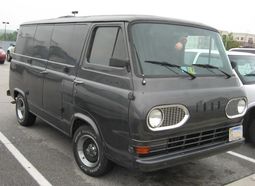


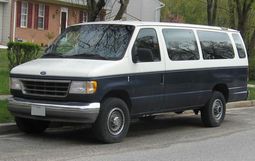
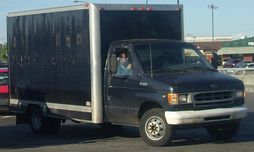

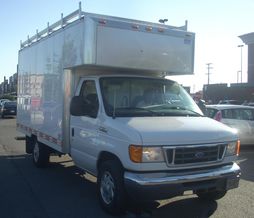

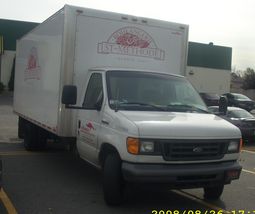
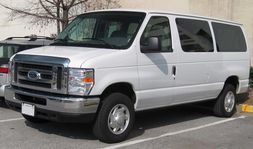
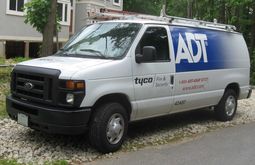
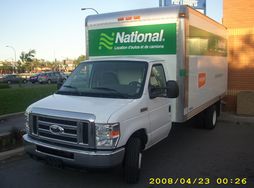
|